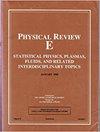Intermediate-times dilemma for open quantum system: Filtered approximation to the refined weak-coupling limit
IF 2.4
3区 物理与天体物理
Q1 Mathematics
引用次数: 0
Abstract
The famous Davies-GKSL secular Markovian master equation is tremendously successful in approximating the evolution of open quantum systems in terms of just a few parameters. However, the fully secular Davies-GKSL equation fails to accurately describe timescales short enough, i.e., comparable to the inverse of differences of frequencies present in the system of interest. A complementary approach that works well for short times but is not suitable after this short interval is known as the quasisecular master equation. Still, both approaches fail to have any faithful dynamics in the intermediate-time interval. Simultaneously, descriptions of dynamics that apply to the aforementioned “gray zone” often are computationally much more complex than master equations or are mathematically not well-structured. The filtered approximation (FA) to the refined weak-coupling limit has the simplistic spirit of the Davies-GKSL equation and allows capturing the dynamics in the intermediate-time regime. At the same time, our non-Markovian equation yields completely positive dynamics. We exemplify the performance of the FA equation in the cases of the spin-boson system and qutrit-boson system in which two distant timescales appear.

开放量子系统的中间时间困境:细化弱耦合极限的过滤近似
著名的戴维斯-GKSL 世俗马尔可夫主方程非常成功地用少量参数逼近了开放量子系统的演化。然而,完全世俗的戴维斯-GKSL方程无法准确描述足够短的时间尺度,即与相关系统中存在的频率差的倒数相当的时间尺度。一种补充方法在短时间内效果很好,但在短时间间隔之后就不适用了,这种方法被称为准十进制主方程。不过,这两种方法都无法在中间时间间隔内获得任何忠实的动态。同时,适用于上述 "灰色区域 "的动力学描述,在计算上往往比主方程复杂得多,或者在数学上结构不严谨。精炼弱耦合极限的滤波近似(FA)具有戴维斯-GKSL方程的简约精神,可以捕捉到中时间体系的动力学。同时,我们的非马尔可夫方程能产生完全正向的动力学。我们以自旋玻色子系统和qutrit玻色子系统为例,说明了FA方程的性能,其中出现了两个遥远的时标。
本文章由计算机程序翻译,如有差异,请以英文原文为准。
求助全文
约1分钟内获得全文
求助全文
来源期刊

Physical review. E
物理-物理:流体与等离子体
CiteScore
4.60
自引率
16.70%
发文量
0
审稿时长
3.3 months
期刊介绍:
Physical Review E (PRE), broad and interdisciplinary in scope, focuses on collective phenomena of many-body systems, with statistical physics and nonlinear dynamics as the central themes of the journal. Physical Review E publishes recent developments in biological and soft matter physics including granular materials, colloids, complex fluids, liquid crystals, and polymers. The journal covers fluid dynamics and plasma physics and includes sections on computational and interdisciplinary physics, for example, complex networks.
 求助内容:
求助内容: 应助结果提醒方式:
应助结果提醒方式:


